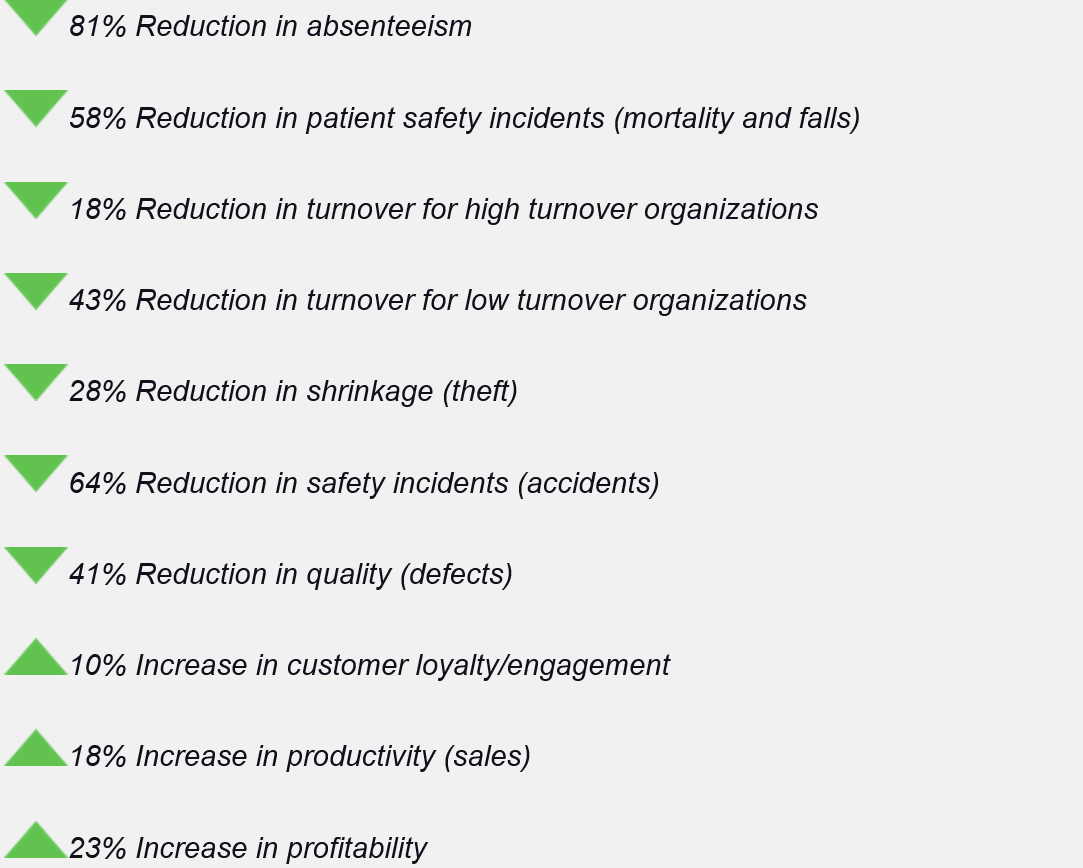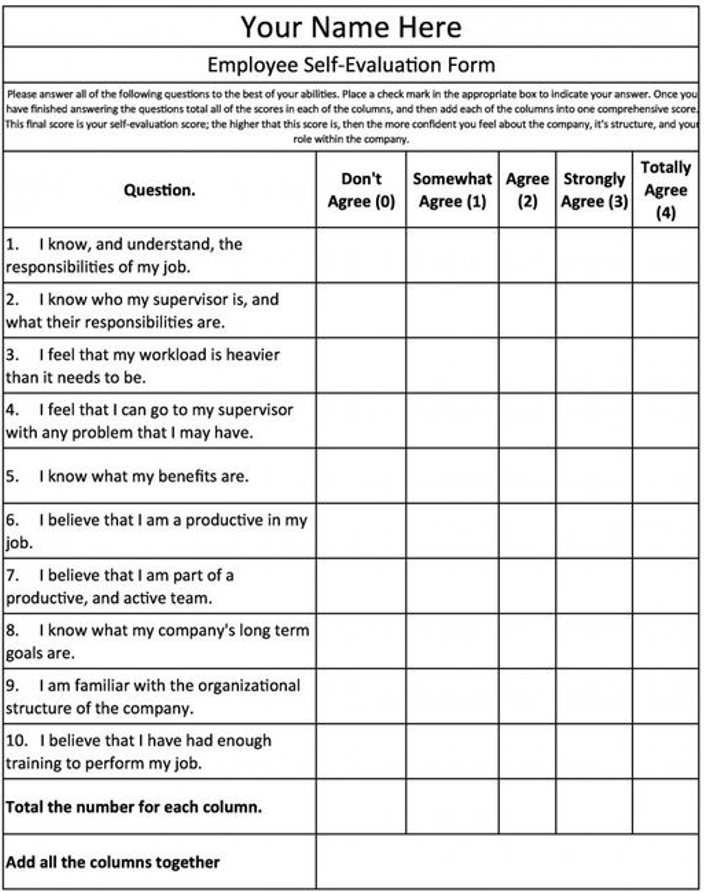A recent Gallup report found that only 36% of people in the United States are enthusiastic about their work. This means that 64% of the workforce is either bored or unhappy with their job.
Employee Engagement
Engagement: “to establish a meaningful contact or connection.”
Employee engagement is the degree to which employees invest their mental, emotional, and professional energies toward positive organizational outcomes. Actively engaged workers generally are enthusiastic about their work and find a greater sense of meaning in what they do. In contrast, disengaged employees tend to put in the minimum effort required, are socially withdrawn from the team, do not participate in meetings, are not punctual, and are generally underachieving.
Engagement & the Work Environment
In regards to working conditions and the work environment, Gallup found that:
“When managers focus on basic human needs, including the social environment such as acceptance, recognition, fairness, and the elimination of mental stressors, employees experience more engagement. In addition, when basic human needs are met, the result is increased productivity, customer retention, and increased sales.”
The benefits of an engaged workforce are quite substantial, particularly in the retail sector (Gallup, 2021):

The State of Employee Engagement
According to the 2021 Gallup report: “employee engagement decreased globally by two percentage points, from 22 percent in 2019 to 20 percent in 2020. Of that percentage, only 36 percent of people polled in the United States reported being highly involved and enthusiastic about the workplace. This lack of engagement indicates an extraordinary waste of organizational productivity from an organizational perspective. Moreover, it means a gross misuse of human potential from a human perspective.”
How is the work environment at your business?
The following questions provide a litmus test to help gauge the level of engagement/disengagement at your retail business:
-
- Do employees clearly understand your business objectives and mission?
- Do employees understand how their role supports the company’s mission and objectives?
- Are employees adequately recognized for supporting the mission and achieving results?
- Have employees been given the tools, training, and motivation required to succeed?
- Is there an irregular level of absenteeism, overscheduling, or under-scheduling of employees?
- Does employee compensation satisfy employee needs?
- Do working conditions facilitate a positive, healthy, and productive work environment?
- Are there any toxic elements that need to be removed from the work environment? (employees, supervisors, or managers)
- Do managers have the knowledge and skills necessary to lead the business?
- Are people in leadership positions able to reinforce company goals positively?
When assessing your business, if you objectively answered “yes” to any one of the above questions, your business likely has at least some disengaged employees. However, if you Responded “yes” to more than three of these questions, it is time to look at how employees perceive the work environment and work conditions.
Research by Gallup defines three levels of employee engagement:
- Engaged employees are enthusiastic and contribute to the goals of the organization. According to Gallup, 14% of employees are “engaged.”
- Not engaged employees put in the minimum effort required of them. According to Gallup, most of the workforce (71%) is “not engaged.”
- Actively disengaged employees show their dissatisfaction at work. According to Gallup, 15% of workers are “actively disengaged.”
Awareness of working conditions and the workplace environment
Decision-makers can improve employee engagement, organizational productivity, and profits by conducting an employee engagement audit. Also, for instance, audits can include surveys or interviews with employees to see how they feel about the company and the work environment. Employee data collection can support strategies to improve employee engagement and retention.
When managers and business owners become aware of the different levels of employee engagement and how they are expressed through employee behavior helps decision-makers understand the work environment.
If the majority of employees are engaged, leadership should be asking, “what are we doing right?” Conversely, when too many employees are disengaged, we need to know why and how to fix it.
The benefits of employing an engaged employee:
- 73% of the customers prefer purchasing from the brands from where they receive a better customer experience. (MyOperator)
- When staff is satisfied, employee productivity increases by 40%, which increases customer satisfaction by 18%, and there is a drop in employee turnover by 14%. (MyOperator)
- A 2% increase in employee engagement leads to a 1% increase in customer satisfaction. (Morrison Management)
- 70% fewer safety incidents occur in highly engaged workplaces(MyOperator)
- 71% of executives say engaged employees are critical to the company’s success (fastrack360)
The data consistently shows that actively engaged employees increase customer loyalty and satisfaction, increasing store sales and customer retention. Plus, setting up your staff for success will feel empowered to represent the brand and be the company’s voice.
Additional benefits of highly engaged employees (Gallup) engaged employees:
- 41% reduction in absenteeism
- 17% increase in productivity
- 24% less turnover in high-turnover organizations
- 10% in customer ratings
- 20% increase in sales
- 21% greater profitability
Note: Actively engaged coworkers accomplish far more than the actively disengaged.
Disengaged employees
- 85% of employees are not engaged in the workplace
- 73% of employees are considering leaving their jobs (Hubspot)
Disengaged workers usually do not enjoy their work and, as a result, do the bare minimum, don’t put in extra effort, and are highly unlikely to say positive things about the company. Moreover, actively disengaged employees may cause problems for coworkers and managers.
In short, disengaged employees don’t want to be there and have no qualms about expressing it. This doesn’t just affect the productivity and output of that individual employee; their negative attitude can also spread to those around them.
The unfortunate part is that they most likely did not have a negative attitude when they started with the company.
The single most significant factor leading to disengagement and turnover is an employee’s relationship with those who (directly) manage them. Spending 40-50 hours each week with someone you don’t like or respect is stressful and takes a toll. Eventually, people withdraw for self-preservation.
Signs of actively disengaged employees:
-
- Reduced productivity and quality of work
- Social withdrawal from the team
- Takes breaks or time off
- Does the minimum amount of work
- Ignoring normal working times
- Increased absenteeism
- Display negative attitude
- Breaking away from routine
- Shows little interest in learning
- Reduced customer satisfaction, sales
Causes of Employee Disengagement
- 69% of employees said they would work harder if they felt appreciated
- 58% of people trust strangers more than they trust their boss (Forbes)
Poor leadership (management) is the leading cause of employee disengagement. There are several types of bad managers, but research shows that “absentee leaders” negatively impact employee satisfaction the most. These are managers who are disconnected from their staff and fail to develop genuine relationships with employees.
Below is a sample survey tool that can be used to evaluate the level of engagement at your retail business:
Is the work environment Toxic?
Here are a few examples of toxic/unhealthy work environments:
Fear-based management
Managers who use fear or negative reinforcement as motivators actively damage the work environment. Furthermore, customers can recognize the poor treatment of employees, either through poor service or catching managers mistreating employees. There is no good outcome for fear-based management. (TopResume)
Lack of employee recognition
There could be many reasons why recognition does not occur in the workplace. It’s vital to start recognizing productive behaviors and excellence.
Toxic Social Environment
Gossip, rumors, bullying, and harassment contribute to a stressful and unhealthy work environment. There must be no tolerance policy for toxic social behavior.
Unethical use of competition
Healthy competition is good as a motivator. However, when managers use competition to pit employees against each other, this leads to fighting, drama, and resentment.
Favoritism
When managers choose favorites, other employees will perceive no matter how hard they work; the favorite will always get the best shifts, bonuses, benefits, promotions, etc.
How to Re-engage the Dis-engaged Employees
Step 1: Identify the disengaged employees
The first step in dealing with the disengaged employee(s) is to become aware of them. Start by identifying disengaged behaviors, as mentioned previously. For instance:
- Whose performance has recently dropped?
- Who has stopped openly communicating?
- Who has suddenly had an increase in absences?
- Who has become withdrawn from the team?
- Who avoids socializing with coworkers?
Step 2: Approach the Disengaged Employee(s)
Meet with the disengaged employees individually and get right to the point. Explain to the employee why the meeting is necessary and that you are concerned about their behavior and lost productivity. Show that you are interested in understanding the root cause of the problem and try not to jump to conclusions. A single meeting with an unhappy employee may allow for a quick resolution.
Note: if the disengagement issue is not isolated to 1-2 employees, you may have a more significant problem requiring further investigation.
Step 3: Work with the Employee to Set Time Based Goals
In meeting with disengaged employees, work together in setting attainable goals. For example, a meeting with the owner or senior management demonstrates urgency and that their contribution to the business is valued (it could also be interpreted negatively). Further, employees will feel more supported when leadership takes a positive and genuine interest in their work.
Note: it is essential to hold the employee accountable by ensuring the goals are measurable, transparent, and have set timeframes.
Step 4: Follow up with Support and Coaching
It is important to follow up with disengaged employees to ensure they progress toward their goals. This can be done and various ways. For example, follow-up meetings, Coaching sessions, advice, and encouragement are a few ways to reinforce goals and demonstrate support.
Note: frequent meetings keep employees engaged by knowing that their manager is interested in their work, progress, skill development, and growth.
Step 5: Recognize and Reward Performance Improvements
- 92% of workers are more likely to repeat a specific action after receiving recognition. (CDA)
- 91% of HR specialists believe that recognition and reward make employees more likely to stay.(CDA)
Acknowledging an employee’s good performance and positive behaviors in a way that aligns with the organization’s culture and that fits the employee’s personality. Even a simple “thank you” goes a long way toward making employees feel noticed and valued. Lastly, it is crucial to recognize exemplary performance promptly. Promptly means soon after the good deeds have been done; this means not a month later.
“People want purpose and meaning from their work. They want to be known for what they’re good at.” (Gallup)
If you’re looking for ways to increase employee engagement, start by meeting the basic needs of your employees. Once their most essential needs are met, they will be more likely to be productive and engaged in their work. Leaders can also create a better workplace by increasing employee engagement and making the workplace more productive. By addressing both the employer and employee needs, we can create an environment that maximizes employee productivity, attracts top talent, and drives sales.
Thank you for reading our article!
TimeWellScheduled.com is a secure, online time and attendance software that is 100% tailored to meet your scheduling needs! In addition, TimeWellScheduled facilitates employee attendance tracking, payroll tasks, and enhances your staff management capabilities. Plus, our service is free for up to 10 employees!
Click: here to download our (Excel) employee scheduling template, IT’s FREE!






